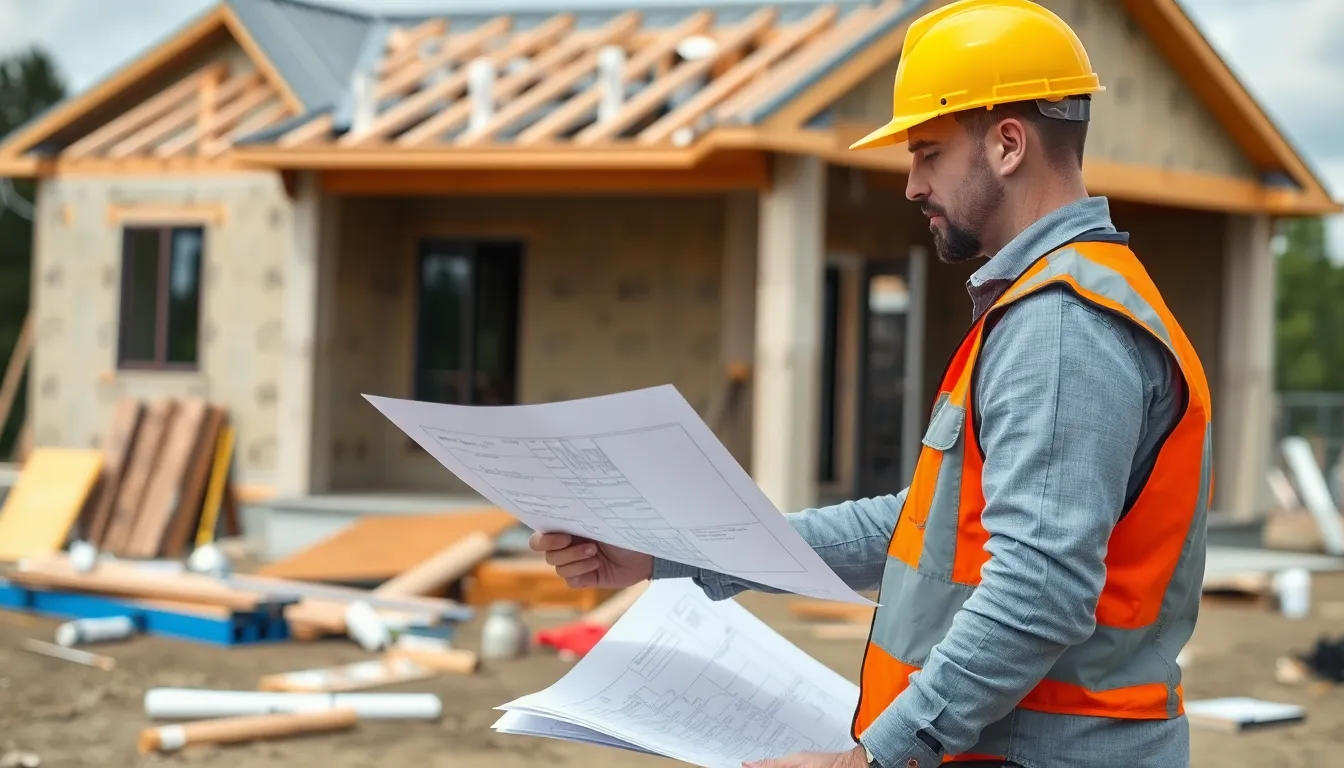Table of Contents
ToggleBuilding a brand-new home is like embarking on a thrilling adventure, but without the right financing, it can feel more like a rollercoaster ride gone wrong. When it comes to mortgages for new construction, many first-time builders find themselves scratching their heads, wondering if they need a degree in rocket science just to secure a loan. Fear not! With the right guidance, navigating this financial maze can be as easy as pie—or at least easier than assembling IKEA furniture.
New construction mortgages come with their own set of perks and quirks. They’re designed to help turn that dream home blueprint into a reality, but understanding the ins and outs can save builders from unexpected headaches. From construction loans to permanent financing, there’s a world of options waiting to be explored. So let’s dive in and uncover how to make that dream home happen without losing your sanity—or your wallet.
Understanding Mortgage For New Construction
Securing a mortgage for new construction involves specific considerations aimed at financing the building of a home. This form of borrowing differs from traditional home loans as it accounts for the unique challenges that new builders face.
What Is A Mortgage For New Construction?
A mortgage for new construction finances the costs associated with building a new home rather than purchasing an existing one. Such mortgages often include funds for labor, materials, and permits. This option allows borrowers to manage expenses during the construction phase without upfront costs. Lenders typically disburse funds in stages, corresponding to construction milestones, ensuring that payments align with project progress.
Types Of Mortgages For New Construction
Multiple mortgage options exist for new construction. Borrowers can choose between construction loans, permanent financing, or a combination of both known as a construction-to-permanent loan. Construction loans offer short-term financing for the building phase, while permanent financing transitions to a standard home mortgage once construction is complete. Each type relates to different needs and timelines specific to individual projects, giving builders flexibility in their financing approaches.
Benefits Of Mortgage For New Construction
New construction mortgages offer several advantages that make them appealing to builders. These loans provide unique financing options that accommodate the specific needs of construction projects.
Customization Options
Customization options allow homeowners to tailor their new home to their preferences. Builders can work closely with their lenders to secure funds that cover personalized features such as layout changes, upgraded materials, and unique finishes. Financing often includes allowances for design choices, which can lead to a more satisfying living environment. When lenders assess construction projects, they may factor in these personalization aspects, ensuring builders get the necessary financial support.
Energy Efficiency Incentives
Energy efficiency incentives enhance the appeal of new construction mortgages. Many lenders offer lower interest rates or additional financing to builders who incorporate energy-efficient systems. These systems might include solar panels, high-performance windows, or advanced insulation materials. The benefits extend beyond immediate savings; homeowners can enjoy reduced utility costs over time. Some federal and state programs also provide tax credits or rebates, further incentivizing environmentally friendly construction practices.
The Application Process
Navigating the application process for a mortgage on new construction involves several critical steps. Pre-approval is essential, as it establishes a borrower’s budget and strengthens their negotiating position.
Pre-Approval Steps
Obtaining pre-approval typically starts with a lender assessing the borrower’s financial profile. Interest rates, credit scores, and income levels all influence this evaluation. Choosing a lender familiar with new construction mortgages enhances the chances of finding favorable terms. After initial assessments, borrowers often receive a pre-approval letter indicating their maximum loan amount. This letter is crucial for builders and sellers, demonstrating that buyers are serious and capable of securing financing.
Required Documentation
Gathering required documentation is vital for the application process. Lenders usually request documents such as recent pay stubs, tax returns, bank statements, and proof of assets. A detailed construction plan may also be necessary, outlining costs, timelines, and contractor information. Providing this documentation ensures that the lender can adequately evaluate the project and borrower’s financial stability. Each document helps paint a clear picture of the borrower’s ability to manage mortgage payments and construction costs, facilitating smoother approval.
Common Challenges
Securing a mortgage for new construction involves facing several common challenges. Understanding these challenges can help builders navigate the process more effectively.
Delays In Construction
Delays in construction frequently occur, impacting timelines and budgets. Weather conditions can postpone work, leading to significant disruptions. Unexpected issues, such as permitting problems or contractor availability, often contribute to these delays. Buyers might face anxiety, especially if they’re on tight deadlines. It’s crucial for builders to communicate with contractors and schedule inspections early to mitigate potential setbacks. Planning for delays can improve overall project management and reduce stress.
Budget Overruns
Budget overruns present another common challenge during new construction projects. Material costs might fluctuate unexpectedly, causing project expenses to rise. Changes in design choices, unexpected site conditions, or additional contractor fees add to the financial strain. Builders should prepare for these increases by maintaining a contingency fund, typically around 10 to 20% of the total budget. Close monitoring of expenditures throughout the construction phase helps stay on track financially. Transparent communication with all parties involved ensures that everyone understands potential costs as the project evolves.
Conclusion
Navigating the mortgage process for new construction can be a complex journey but it doesn’t have to be overwhelming. With the right information and support, first-time builders can successfully secure financing tailored to their unique needs. Understanding the different types of mortgages available and the importance of pre-approval can significantly enhance their experience.
By planning ahead and maintaining open communication with lenders and contractors, builders can effectively manage challenges like budget overruns and construction delays. Ultimately, a well-structured mortgage for new construction not only finances the dream home but also paves the way for a rewarding building experience.









